Effects of Mead Wort Heat Treatment on the Mead Fermentation Process and Antioxidant Activity
Abstract
:1. Introduction
2. Results
2.1. General
2.2. Phenolic Compounds and Antioxidant Activity
2.3. Acetic Acid and HMF Content
3. Discussion
4. Materials and Methods
4.1. Biological Material
4.2. Mead Wort Preparation
4.3. Fermentation
4.4. Analytical Methods
4.4.1. Specific Gravity, Sugars Profile and Ethanol Determination
Specific Gravity
Sugars Profile Determination
Determination of Post-Fermentation Products
4.4.2. Phenolic Compound Analysis
Determination of Total Polyphenols Content
Determination of Antioxidant Activity in the Reaction with DPPH (2,2-diphenyl-2-picrylhydrazyl) Radical
Determination of Antioxidant Activity in the Reaction with ABTS (2,2’-azino-bis(3-ethylbenzo-thiazoline-6-sulfonic acid)) Cation Radical
Determination of Antioxidant Activity in the Reaction with FRAP (ferric 2,4,6-tris(2-pyridyl)-1,3,5-triazine [Fe(III)-TPTZ])
4.4.3. 5-Hydroxymethylfurfural (HMF) Determination using High Performance Liquid Chromatography (HPLC)
4.4.4. Statistics
5. Conclusions
Acknowledgments
Author Contributions
Conflicts of Interest
References
- Kahoun, D.; Řezková, S.; Veškrnová, K.; Královský, J.; Holčapek, M. Determination of phenolic compounds and hydroxymethylfurfural in meads using high performance liquid chromatography with coulometric-array and UV detection. J. Chromatogr. A 2008, 1202, 19–33. [Google Scholar] [CrossRef] [PubMed]
- Sroka, P.; Tuszyński, T. Changes in organic acid contents during mead wort fermentation. Food Chem. 2007, 104, 1250–1257. [Google Scholar] [CrossRef]
- Mendes-Ferreira, A.; Cosme, F.; Barbosa, C.; Falco, V.; Inês, A.; Mendes-Faia, A. Optimization of honey-must preparation and alcoholic fermentation by Saccharomyces cerevisiae for mead production. Int. J. Food Microbiol. 2010, 144, 193–198. [Google Scholar] [CrossRef] [PubMed]
- Begum, S.B.; Roobia, R.R.; Karthikeyan, M.; Murugappan, R.M. Validation of nutraceutical properties of honey and probiotic potential of its innate microflora. LWT Food Sci. Technol. 2015, 60, 743–750. [Google Scholar] [CrossRef]
- Taherzadeh, M.J.; Niklasson, C.; Liden, G. Acetic Acid-Friend or Foe in Anaerobic Batch Conversion of Glucose to Ethanol by Saccharomyces cerevisiae? Chem. Eng. Sci. 1997, 52, 2653–2659. [Google Scholar] [CrossRef]
- Šmogrovičová, D.; Nádaský, P.; Lich, R.T.; Wilhelmi, B.S.; Cambray, G. Analytical and aroma profiles of Slovak and South African meads. Czech J. Food Sci. 2012, 30, 241–246. [Google Scholar]
- Iglesias, A.; Pascoal, A.; Choupina, A.B.; Carvalho, C.A.; Feás, X.; Estevinho, L.M. Developments in the fermentation process and quality improvement strategies for mead production. Molecules 2014, 19, 12577–12590. [Google Scholar] [CrossRef] [PubMed]
- Czabaj, S.; Kawa-Rygielska, J.; Dziuba, E.; Foszczyńska, B.; Kliks, J. Maturation process and its influence on mead quality. Acta Sci. Pol. Biotechnol. 2016, 15, 5–14. [Google Scholar]
- Nemś, A.; Pęksa, A.; Kucharska, A.Z.; Sokół-Łętowska, A.; Kita, A.; Drozdz, W.; Hamouz, K. Anthocyanin and antioxidant activity of snacks with coloured potato. Food Chem. 2015, 172, 175–182. [Google Scholar] [CrossRef] [PubMed]
- Kahoun, D.; Rezkova, S.; Kralovsky, J. Effect of heat treatment and storage conditions on mead composition. Food Chem. 2017, 219, 357–363. [Google Scholar] [CrossRef] [PubMed]
- Wintersteen, C.L.; Andrae, L.M.; Engeseth, N.J. Effect of Heat Treatment on Antioxidant Capacity and Flavor Volatiles of Mead. J. Food Sci. 2005, 70, C119. [Google Scholar] [CrossRef]
- International Conference on Harmonization Validation of Analytical Procedures; European Medicines Agency: London, UK, 1995; pp. 1–15.
- PN-A-79123:1999 Miód pitny; Polski Komitet Normalizacyjny: Warszawa, Poland.
- European Commission. Regulation (EU) No 1151/2012 of the European Parliament and of the Council on quality schemes for agricultural products and foodstuffs. Off. J. Eur. Union 2003, 341, 1–29. [Google Scholar]
- European Comission. European Commission Council Directive 2001/110/EC of 20 December 2001 relating to honey. Off. J. Eur. Communities 2002, 10, 47–52. [Google Scholar]
- Hohmann, S. Osmotic stress signaling and osmoadaptation in yeasts. Microbiol. Mol. Biol. Rev. 2002, 66, 300–372. [Google Scholar] [CrossRef] [PubMed]
- Serem, J.C.; Bester, M.J. Physicochemical properties, antioxidant activity and cellular protective effects of honeys from southern Africa. Food Chem. 2012, 133, 1544–1550. [Google Scholar] [CrossRef]
- Wang, X.H.; Gheldof, N.; Engeseth, N.J. Effect of processing and storage on antioxidant capacity of honey. J. Food Sci. 2004, 69, 96–101. [Google Scholar] [CrossRef]
- European Directorate for the Quality of Medicines & Health Care (EDQM Council of Europe) Honey (Mel). In European Pharmacopoeia 8.0; Concil of Europe: Strasbourg, France, 2008; Volume 1, pp. 2403–2404.
- Rice-Evans, C.; Miller, N.; Paganga, G. Antioxidant properties of phenolic compounds. Trends Plant Sci. 1997, 2, 152–159. [Google Scholar] [CrossRef]
- Yen, G.-C.; Chen, H.-Y. Antioxidant Activity of Vaious Tea Extracts in Relation to Their Antimutagenicity. J. Agric. Food Chem. 1995, 43, 27–32. [Google Scholar] [CrossRef]
- Bravo, L. Polyphenols: Chemistry, Dietary Sources, Metabolism, and Nutritional Significance. Nutr. Rev. 1998, 56, 317–333. [Google Scholar] [CrossRef] [PubMed]
- Eteraf-Oskouei, T.; Najafi, M. Traditional and modern uses of natural honey in human diseases: A review. Iran. J. Basic Med. Sci. 2013, 16, 731–742. [Google Scholar] [PubMed]
- Chang, K.J.; Liz Thach, M.; Olsen, J. Wine and Health Perceptions: Exploring the Impact of Gender, Age and Ethnicity on Consumer Perceptions of Wine and Health. Wine Econ. Policy 2016, 5, 105–113. [Google Scholar] [CrossRef]
- Prior, R.L.; Wu, X.; Schaich, K. Standardized methods for the determination of antioxidant capacity and phenolics in foods and dietary supplements. J. Agric. Food Chem. 2005, 53, 4290–4302. [Google Scholar] [CrossRef] [PubMed]
- Motilva, M.J.; Macià, A.; Romero, M.P.; Rubió, L.; Mercader, M.; González-Ferrero, C. Human bioavailability and metabolism of phenolic compounds from red wine enriched with free or nano-encapsulated phenolic extract. J. Funct. Foods 2016, 25, 80–93. [Google Scholar] [CrossRef]
- Pereira, V.; Albuquerque, F.M.; Ferreira, A.C.; Cacho, J.; Marques, J.C. Evolution of 5-hydroxymethylfurfural (HMF) and furfural (F) in fortified wines submitted to overheating conditions. Food Res. Int. 2011, 44, 71–76. [Google Scholar] [CrossRef]
- Tosi, E.; Ciappini, M.; Re, E.; Lucero, H. Honey thermal treatment effects on hydroxymethylfurfural content. Food Chem. 2002, 77, 71–74. [Google Scholar] [CrossRef]
- Serra-Cayuela, A.; Aguilera-Curiel, M.A.; Riu-Aumatell, M.; Buxaderas, S.; López-Tamames, E. Browning during biological aging and commercial storage of Cava sparkling wine and the use of 5-HMF as a quality marker. Food Res. Int. 2013, 53, 226–231. [Google Scholar] [CrossRef]
- Da Silva, P.M.; Gauche, C.; Gonzaga, L.V.; Costa, A.C.O.; Fett, R. Honey: Chemical composition, stability and authenticity. Food Chem. 2016, 196, 309–323. [Google Scholar] [CrossRef] [PubMed]
- Moon, J.; Liu, Z.L. Engineered NADH-dependent GRE2 from Saccharomyces cerevisiae by directed enzyme evolution enhances HMF reduction using additional cofactor NADPH. Enzyme Microb. Technol. 2012, 50, 115–120. [Google Scholar] [CrossRef] [PubMed]
- Švecová, B.; Bordovská, M.; Kalvachová, D.; Hájek, T. Analysis of Czech meads: Sugar content, organic acids content and selected phenolic compounds content. J. Food Compos. Anal. 2015, 38, 80–88. [Google Scholar] [CrossRef]
- Samborska, K.; Czelejewska, M. The Influence of Thermal Treatment and Spray Drying on the Physicochemical Properties of Polish Honeys. J. Food Process. Preserv. 2014, 38, 413–419. [Google Scholar] [CrossRef]
- Gawel, R.; Van Sluyter, S.; Waters, E.J. The effects of ethanol and glycerol on the body and other sensory characteristics of Riesling wines. Aust. J. Grape Wine Res. 2007, 13, 38–45. [Google Scholar] [CrossRef]
- Stefan, B. Harmonised Methods of the International Honey Commission. Int. Honey Comm. 2009, 1–63. [Google Scholar]
- Kawa-Rygielska, J.; Pietrzak, W.; Regiec, P.; Stencel, P. Utilization of concentrate after membrane filtration of sugar beet thin juice for ethanol production. Bioresour. Technol. 2013, 133, 134–141. [Google Scholar] [CrossRef] [PubMed]
- Re, R.; Pellegrini, N.; Proteggente, A.; Pannala, A.; Yang, M.; Rice-Evans, C. Antioxidant Activity Applying an Improved Abts Radical Cation Decolorization Assay. Free Radic. Biol. Med. 1999, 26, 1231–1237. [Google Scholar] [CrossRef]
- Benzie, I.F.; Strain, J.J. The ferric reducing ability of plasma (FRAP) as a measure of “antioxidant power”: The FRAP assay. Anal. Biochem. 1996, 239, 70–76. [Google Scholar] [CrossRef] [PubMed]
Sample Availability: Samples of the meads are available from the authors. |
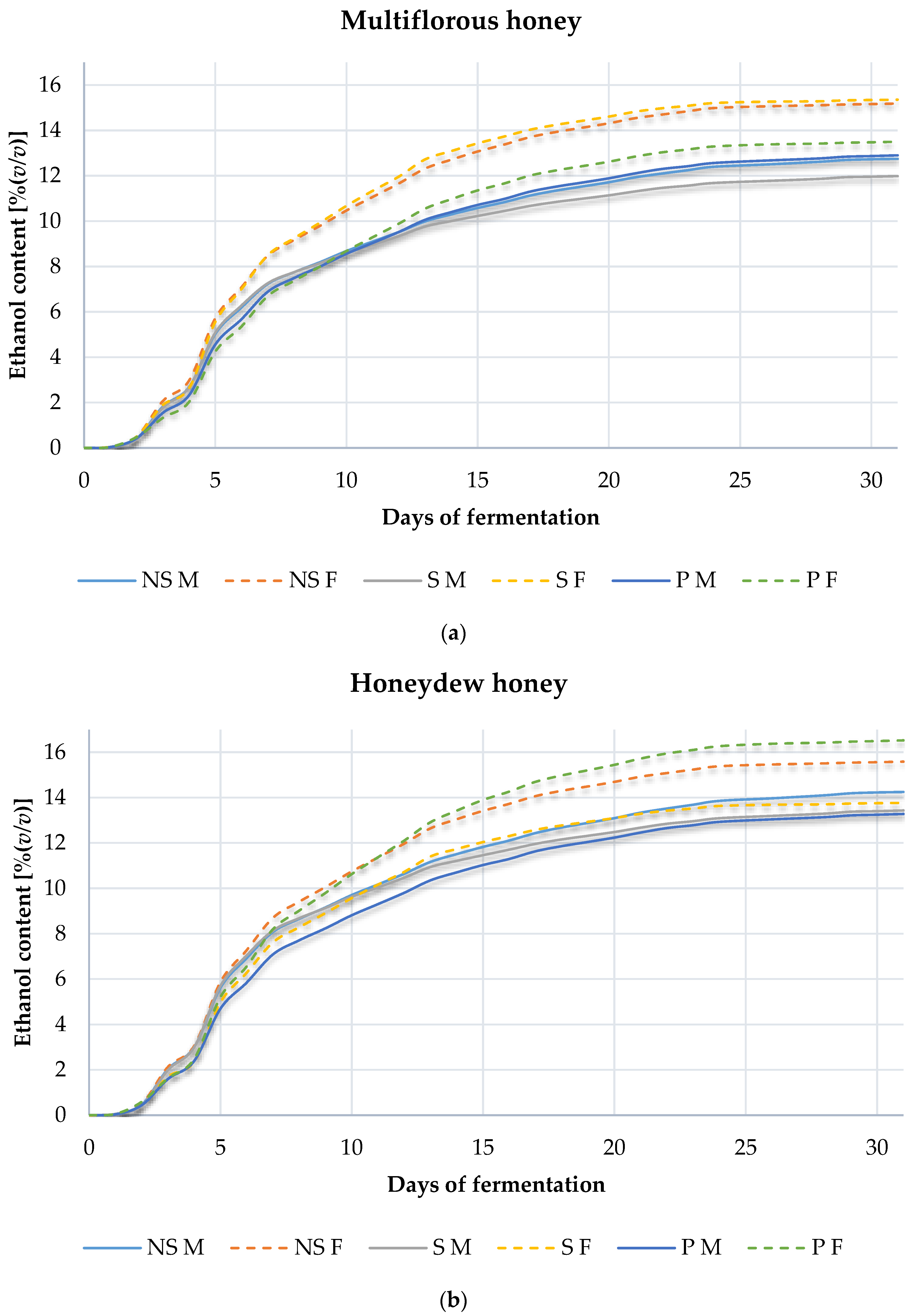
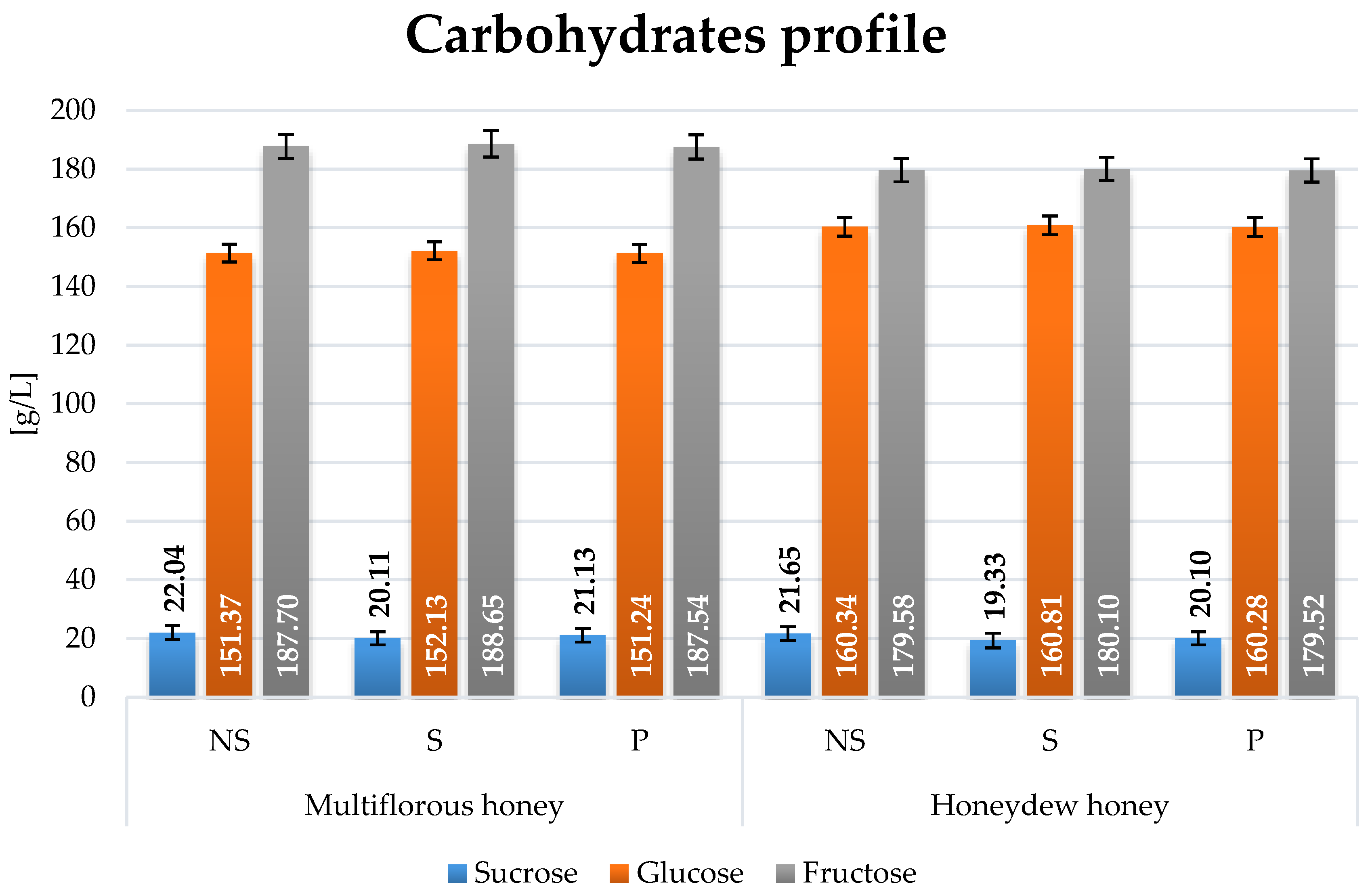
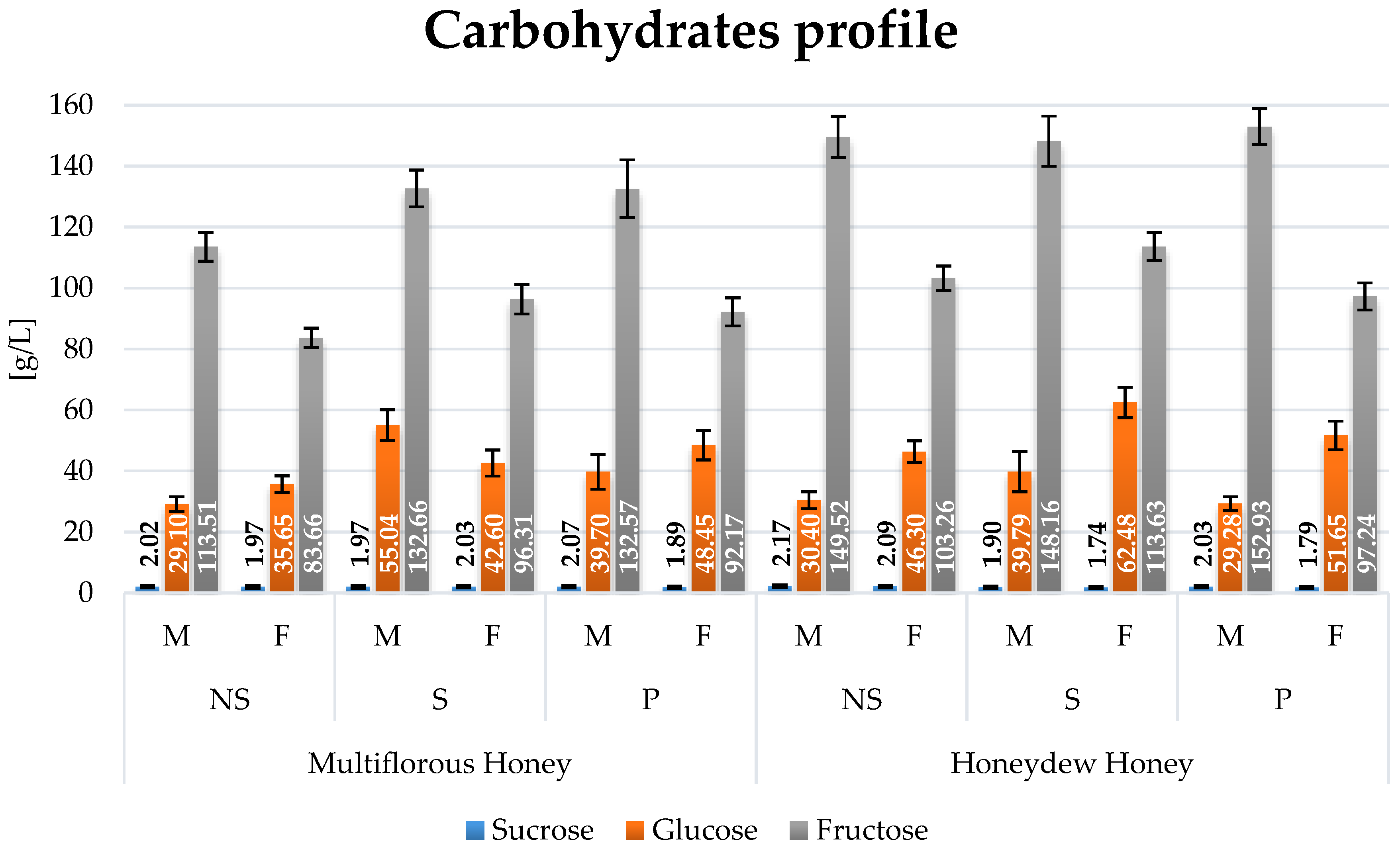
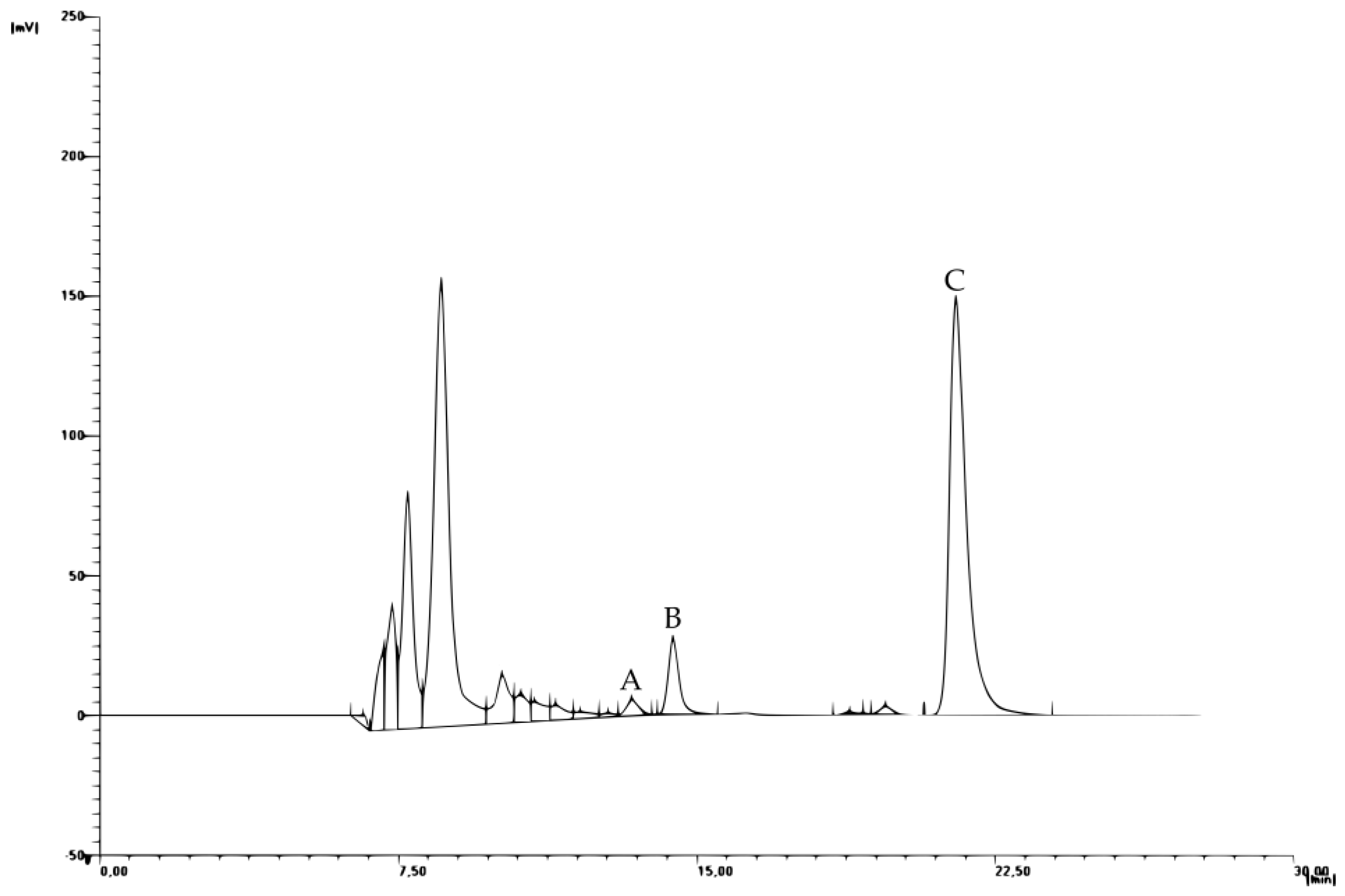

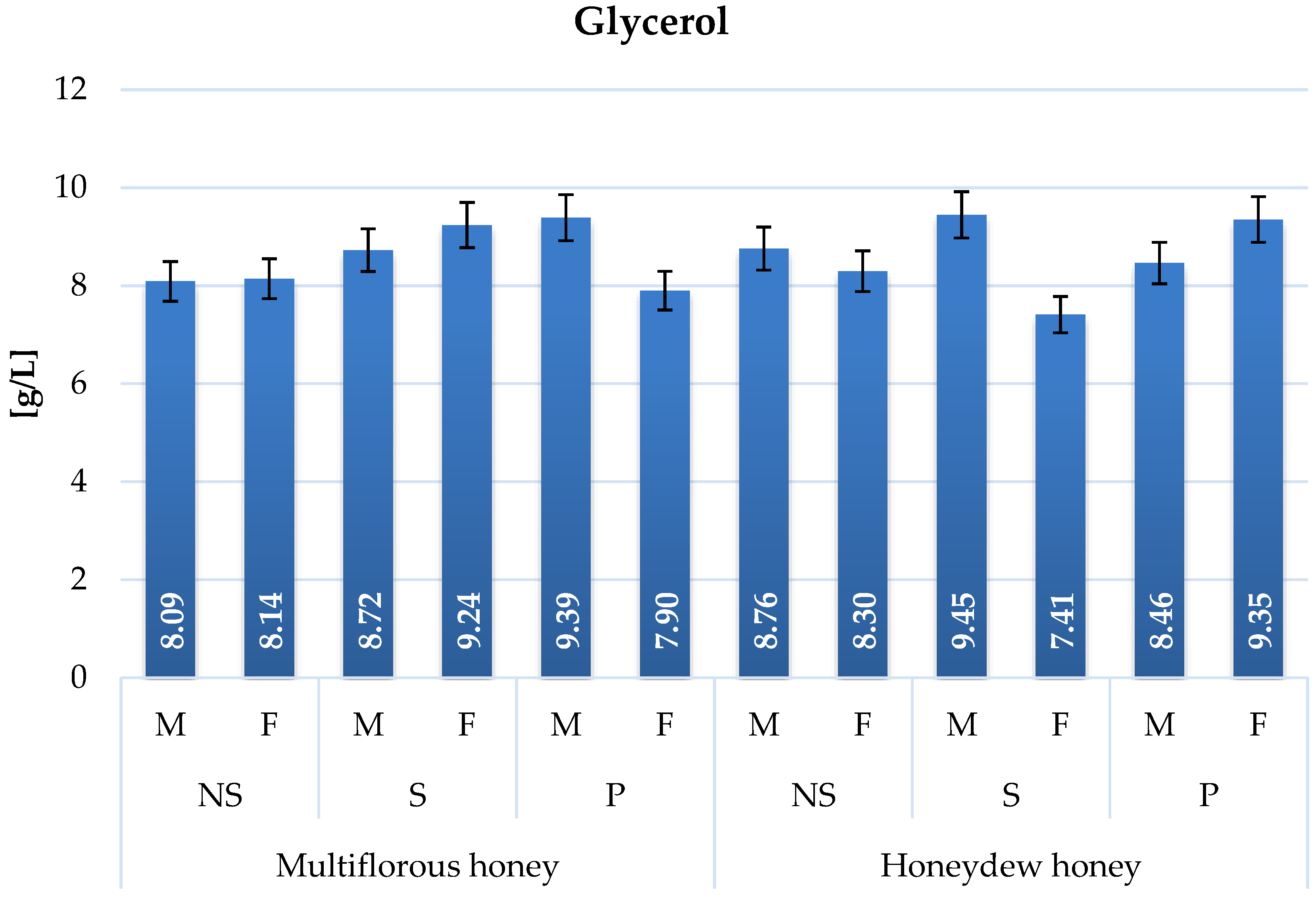
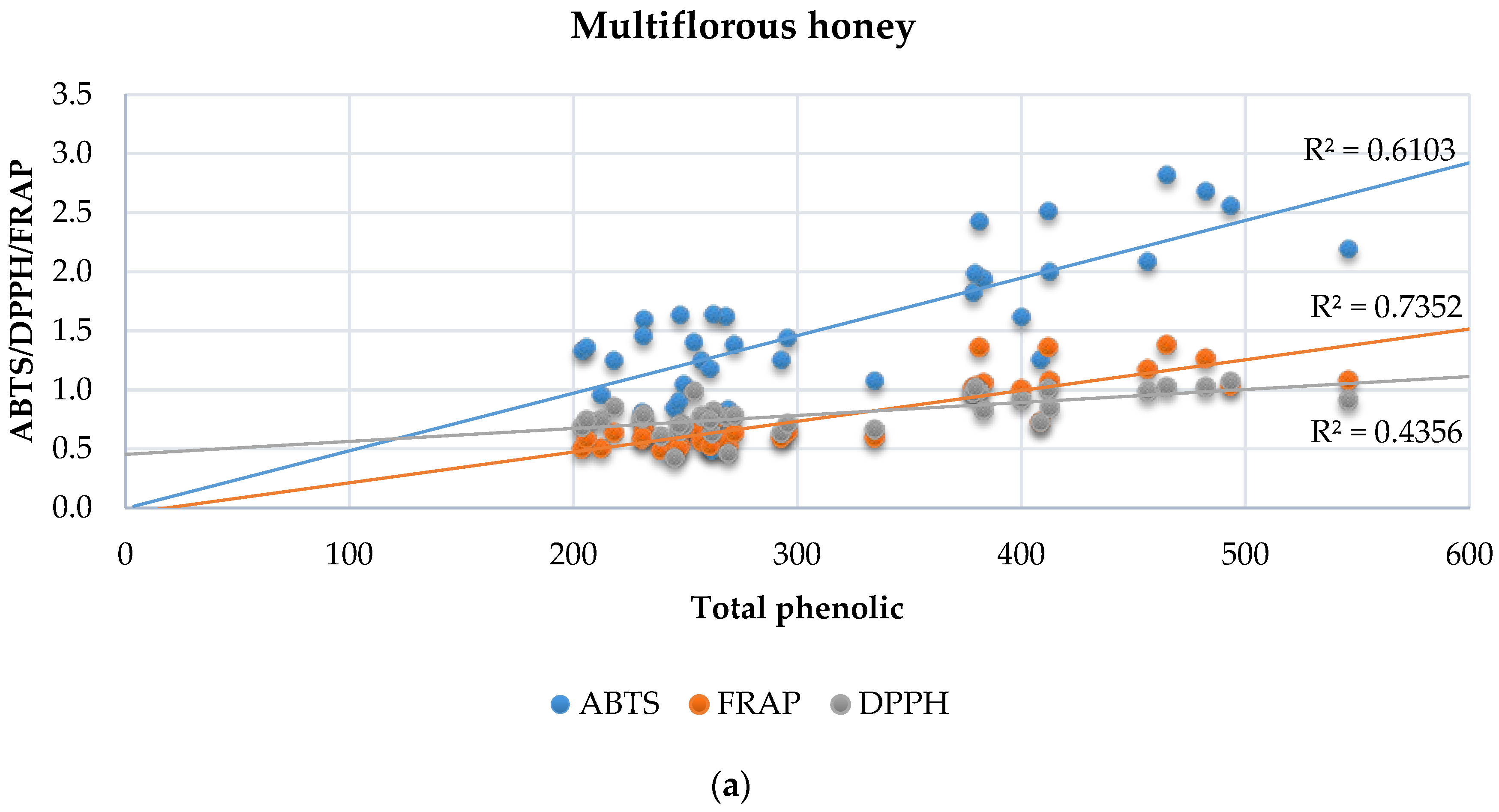

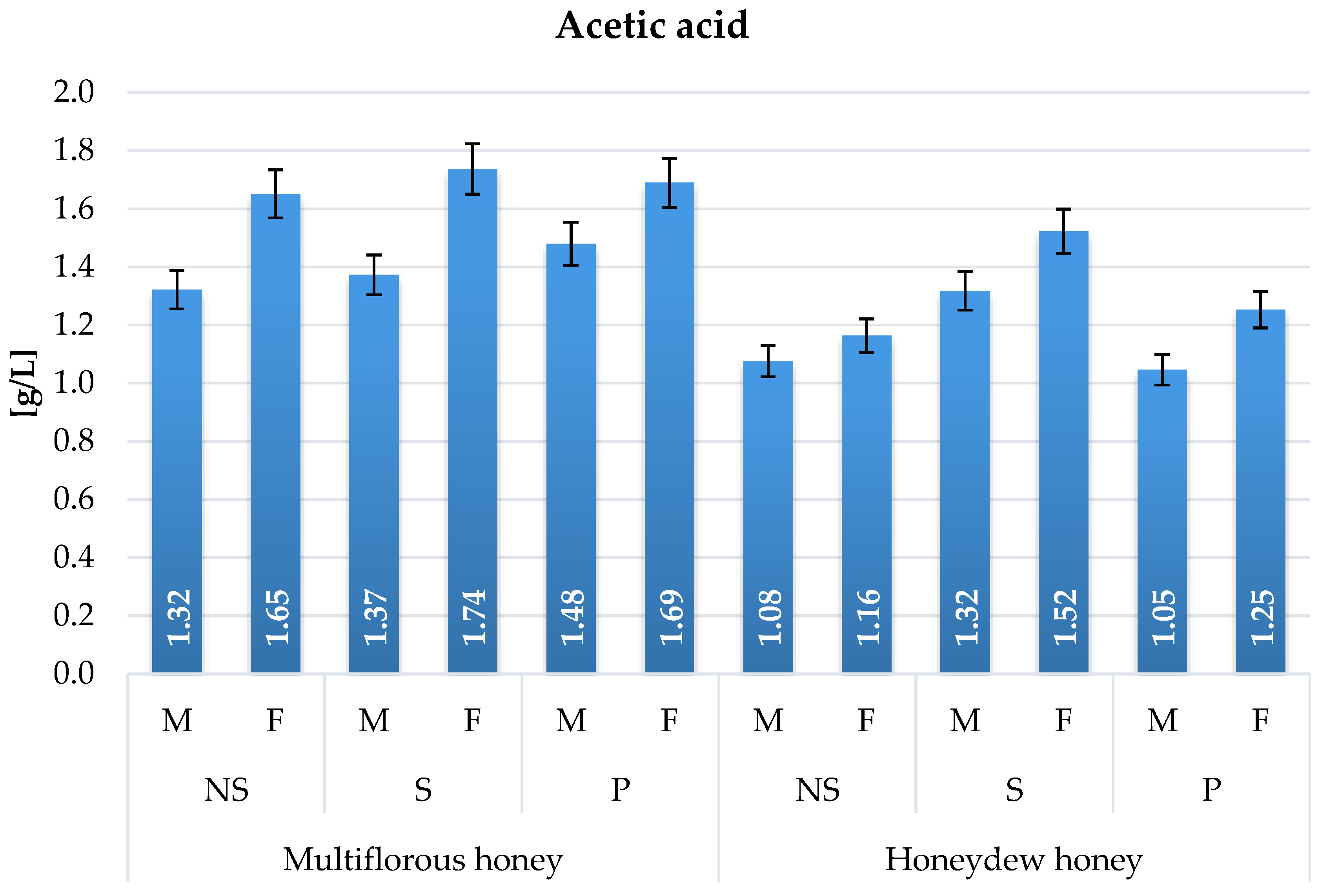
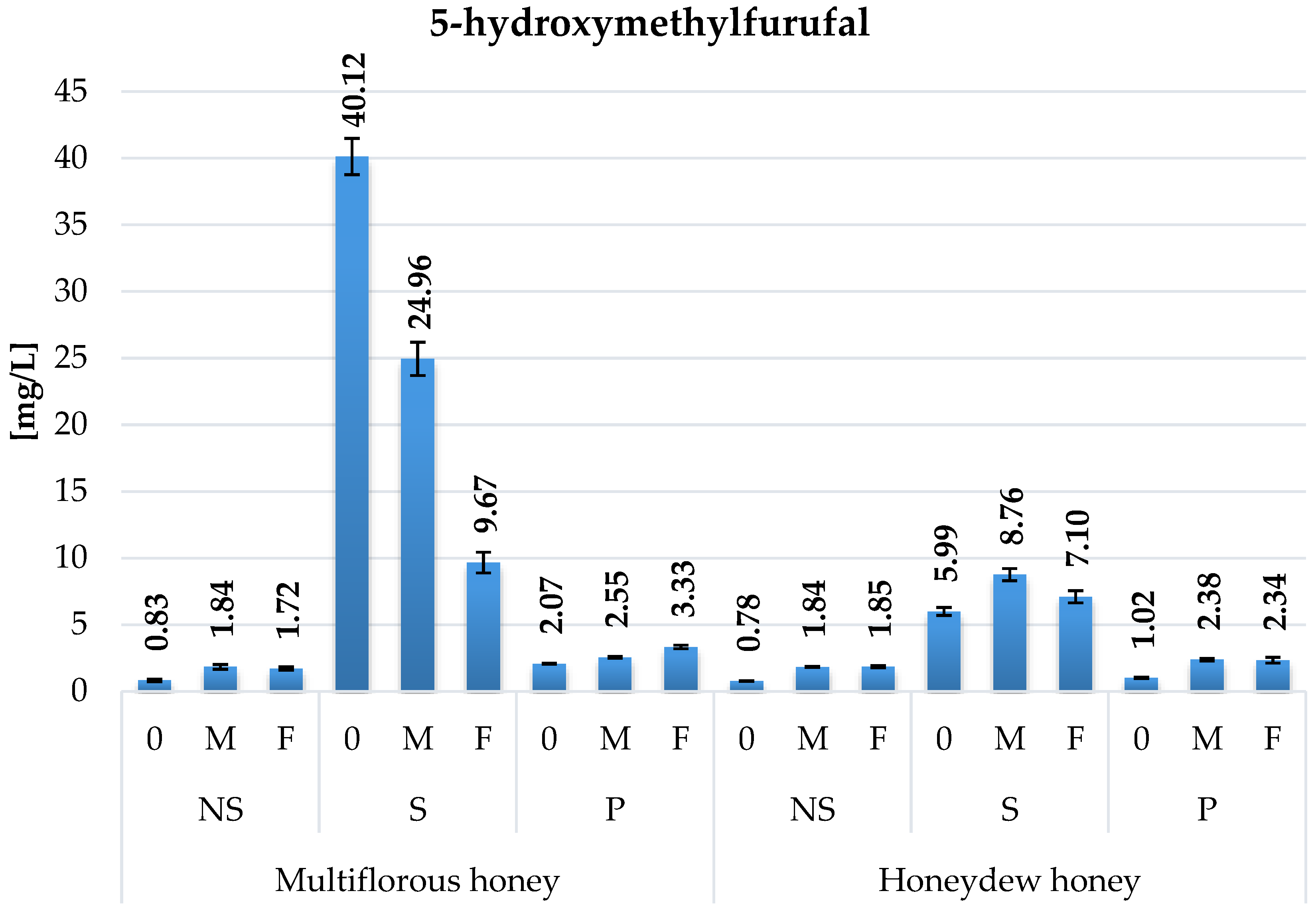
| Honey type | Heat treatment | Yeast strain | ABTS●+ | FRAP | DPPH● | Total phenolic | ||||||||||||||||||||||||||||
|---|---|---|---|---|---|---|---|---|---|---|---|---|---|---|---|---|---|---|---|---|---|---|---|---|---|---|---|---|---|---|---|---|---|---|
| Mean [mM TE/L] | SD ± [mM TE/L] | Mean [mM TE/L] | SD ± [mM TE/L] | Mean [mM TE/L] | SD ± [mM TE/L] | Mean [mg GAE/L] | SD ± [mg GAE/L] | |||||||||||||||||||||||||||
| Multiflorus | NS | 0 | 1.21 | ● | b | ● | b | ● | b | 0.19 | 0.60 | ● | b | ● | c | b | c, d | 0.07 | 0.86 | ● | b | ● | b | a | c | 0.10 | 228.00 | a | b | ● | b | a | c | 18.32 |
| F | 1.28 | ● | b | ● | b | ● | b | 0.49 | 0.53 | ● | b | ● | c | a | c, d | 0.03 | 0.68 | ● | b | ● | b | a | c | 0.07 | 251.50 | a | b | ● | b | a | c | 12.12 | ||
| M | 1.35 | ● | b | ● | b | ● | b | 0.38 | 0.66 | ● | b | ● | c | a, b | b, c | 0.06 | 0.78 | ● | b | ● | b | a | b, c | 0.03 | 241.47 | a | b | ● | b | a | c | 14.81 | ||
| S | 0 | 2.59 | ● | a | ● | a | ● | a | 0.17 | 1.37 | ● | a | ● | a | b | a | 0.01 | 1.01 | ● | a | ● | a | a | b, c | 0.01 | 419.27 | a | a | ● | a | a | a, b | 34.57 | |
| F | 2.13 | ● | a | ● | a | ● | a | 0.32 | 1.03 | ● | a | ● | a | a | a | 0.01 | 1.02 | ● | a | ● | a | a | a | 0.04 | 416.97 | a | a | ● | a | a | a | 53.98 | ||
| M | 2.13 | ● | a | ● | a | ● | a | 0.44 | 1.15 | ● | a | ● | a | a, b | a | 0.11 | 0.98 | ● | a | ● | a | a | a, b | 0.04 | 446.10 | a | a | ● | a | a | a | 34.35 | ||
| P | 0 | 1.05 | ● | b | ● | b | ● | b | 0.16 | 0.58 | ● | b | ● | c | b | b | 0.06 | 0.63 | ● | b | ● | b | a | d | 0.15 | 250.43 | a | b | ● | b | a | c | 5.02 | |
| F | 1.16 | ● | b | ● | b | ● | b | 0.20 | 0.56 | ● | b | ● | c | a | d | 0.06 | 0.75 | ● | b | ● | b | a | c | 0.03 | 259.87 | a | b | ● | b | a | b | 10.11 | ||
| M | 1.39 | ● | b | ● | b | ● | b | 0.05 | 0.56 | ● | b | ● | c | a, b | c, d | 0.04 | 0.74 | ● | b | ● | b | a | c | 0.04 | 213.57 | a | b | ● | b | a | d | 12.42 | ||
| Honeydew | NS | 0 | 1.81 | ● | b | ● | b | ● | b | 0.49 | 0.72 | ● | b | ● | b | b | c, d | 0.07 | 0.68 | ● | b | ● | b | b | c | 0.16 | 247.23 | b | b | ● | b | b | c | 47.25 |
| F | 1.39 | ● | b | ● | b | ● | b | 0.25 | 0.67 | ● | b | ● | b | b | c, d | 0.05 | 0.85 | ● | b | ● | b | a | c | 0.02 | 231.37 | b | b | ● | b | a | c | 15.78 | ||
| M | 1.19 | ● | b | ● | b | ● | b | 0.10 | 0.87 | ● | b | ● | b | b | b, c | 0.15 | 0.84 | ● | b | ● | b | a | b, c | 0.02 | 218.97 | b | b | ● | b | b | c | 20.21 | ||
| S | 0 | 1.93 | ● | a | ● | a | ● | a | 0.24 | 0.86 | ● | a | ● | a | b | a | 0.01 | 0.62 | ● | a | ● | b | b | b, c | 0.01 | 254.80 | b | a | ● | b | b | a, b | 17.64 | |
| F | 2.20 | ● | a | ● | a | ● | a | 0.39 | 1.27 | ● | a | ● | a | b | c, d | 0.13 | 0.86 | ● | a | ● | b | a | a | 0.08 | 269.57 | b | a | ● | b | a | a | 13.73 | ||
| M | 2.13 | ● | a | ● | a | ● | a | 0.27 | 1.16 | ● | a | ● | a | b | a | 0.09 | 0.87 | ● | a | ● | b | a | a, b | 0.07 | 266.40 | b | a | ● | b | b | a | 13.05 | ||
| P | 0 | 1.45 | ● | b | ● | b | ● | b | 0.35 | 1.21 | ● | b | ● | b | b | b | 0.32 | 0.59 | ● | b | ● | b | b | d | 0.12 | 215.67 | b | b | ● | b | b | c | 18.45 | |
| F | 1.43 | ● | b | ● | b | ● | b | 0.10 | 0.82 | ● | b | ● | b | b | b | 0.14 | 0.73 | ● | b | ● | b | a | c | 0.11 | 248.80 | b | b | ● | b | a | b | 5.28 | ||
| M | 1.12 | ● | b | ● | b | ● | b | 0.30 | 0.54 | ● | b | ● | b | b | d | 0.07 | 0.83 | ● | b | ● | b | a | c | 0.04 | 177.30 | b | b | ● | b | b | d | 10.95 | ||
© 2017 by the authors. Licensee MDPI, Basel, Switzerland. This article is an open access article distributed under the terms and conditions of the Creative Commons Attribution (CC BY) license (http://creativecommons.org/licenses/by/4.0/).
Share and Cite
Czabaj, S.; Kawa-Rygielska, J.; Kucharska, A.Z.; Kliks, J. Effects of Mead Wort Heat Treatment on the Mead Fermentation Process and Antioxidant Activity. Molecules 2017, 22, 803. https://doi.org/10.3390/molecules22050803
Czabaj S, Kawa-Rygielska J, Kucharska AZ, Kliks J. Effects of Mead Wort Heat Treatment on the Mead Fermentation Process and Antioxidant Activity. Molecules. 2017; 22(5):803. https://doi.org/10.3390/molecules22050803
Chicago/Turabian StyleCzabaj, Sławomir, Joanna Kawa-Rygielska, Alicja Z. Kucharska, and Jarosław Kliks. 2017. "Effects of Mead Wort Heat Treatment on the Mead Fermentation Process and Antioxidant Activity" Molecules 22, no. 5: 803. https://doi.org/10.3390/molecules22050803






